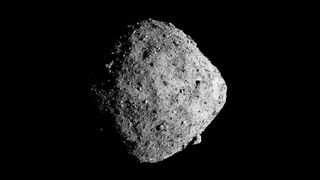NASA to Unveil New Discoveries from Asteroid Bennu
Update: NASA's live webcast has ended. You can read our first story on NASA's asteroid Bennu discoveries here.
NASA will announce new science results from its first-ever asteroid sample return mission in a live teleconference today (March 19) at 1:30 p.m. EDT (1730 GMT).
The agency's OSIRIS-REx (Origins-Spectral Interpretation-Resource Identification-Security-Regolith Explorer) spacecraft arrived at the asteroid 101955 Bennu in December after a two-year trek to the distant space rock. OSIRIS-REx is now orbiting Bennu, surveying and mapping the asteroid while looking for a good spot to swoop down and scoop up a sample of asteroid dirt, which it will bring back to Earth in 2023.
So, what kind of big announcement can we expect from OSIRIS-REx today? Has the spacecraft spotted a potential landing site, or did the mission uncover new scientific mysteries at Bennu? NASA hasn't dropped any hints about the details, but you can tune in to find out! A live stream of today's teleconference will appear in the window above. You can also tune in via nasa.gov/nasalive.
Related: OSIRIS-REx: NASA's Asteroid Sample-Return Mission in Pictures

"NASA is hosting a media teleconference at 1:30 p.m. EDT Tuesday, March 19, to announce new science from the agency’s first mission to return to Earth an asteroid sample that may contain unaltered material from the very beginning of our solar system.
Get the Space.com Newsletter
Breaking space news, the latest updates on rocket launches, skywatching events and more!
"The Origins, Spectral Interpretation, Resource Identification, Security-Regolith Explorer (OSIRIS-REx) spacecraft launched Sept. 8, 2016, and began orbiting the asteroid Bennu on Dec. 31, 2018. Since its arrival at Bennu, the probe has been investigating the asteroid and searching for an ideal site for sample collection.
"Bennu is only slightly wider than the height of the Empire State Building and is the smallest body ever orbited by spacecraft. Studying Bennu with OSIRIS-REx will allow researchers to learn more about the origins of our solar system, the sources of water and organic molecules on Earth, and the hazards and resources in near-Earth space."
The teleconference participants are:
- Lori Glaze, acting director, NASA’s Planetary Science Division, Washington
- Dante Lauretta, OSIRIS-REx principal investigator, University of Arizona, Tucson
- Coralie Adam, OSIRIS-REx flight navigator, KinetX, Inc. Space Navigation and Flight Dynamics, Simi Valley, Calif.
- Rich Burns, OSIRIS-REx project manager, NASA’s Goddard Space Flight Center, Greenbelt, Md.
Teleconference audio and visuals will stream live at: https://www.nasa.gov/live
For more information about NASA’s OSIRIS-REx mission, visit: https://www.nasa.gov/osiris-rex
Related:
Join our Space Forums to keep talking space on the latest missions, night sky and more! And if you have a news tip, correction or comment, let us know at: community@space.com.

Hanneke Weitering is a multimedia journalist in the Pacific Northwest reporting on the future of aviation at FutureFlight.aero and Aviation International News and was previously the Editor for Spaceflight and Astronomy news here at Space.com. As an editor with over 10 years of experience in science journalism she has previously written for Scholastic Classroom Magazines, MedPage Today and The Joint Institute for Computational Sciences at Oak Ridge National Laboratory. After studying physics at the University of Tennessee in her hometown of Knoxville, she earned her graduate degree in Science, Health and Environmental Reporting (SHERP) from New York University. Hanneke joined the Space.com team in 2016 as a staff writer and producer, covering topics including spaceflight and astronomy. She currently lives in Seattle, home of the Space Needle, with her cat and two snakes. In her spare time, Hanneke enjoys exploring the Rocky Mountains, basking in nature and looking for dark skies to gaze at the cosmos.
